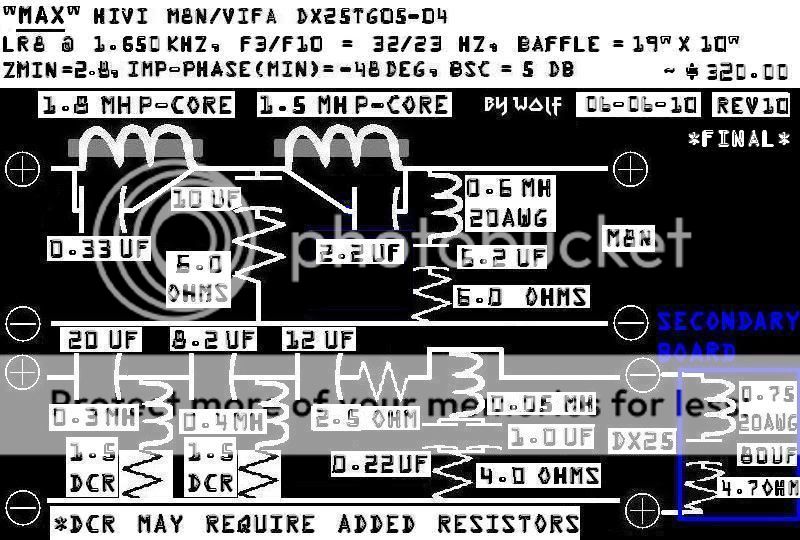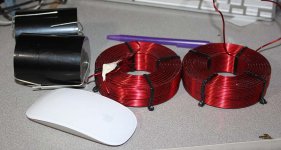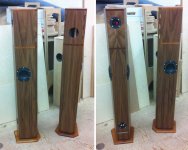With the availability of better and cheaper amps, class D boards in particular, it makes less and less sense to design multi-way speaker systems with passive crossovers.
One of the big issues is the crossover point between the woofer and the next stage, be it the mid or the tweeter. The woofer is the only driver in the system that is expected to operate down to and below its own natural resonance. This fact makes it critical to have as little DC resistance between the power amp and the woofer voice coil. What is the point of spending a fortune on super low resistance speaker cables if the first thing the signal has to go through inside the box is a giant coil of solid copper wire?
Most woofer crossover points are well into the mid-range and the piston motion of the woofer cone adds a lot of inter-modulation distortion to the mids. Woofers should be crossed over below 300, even below 150Hz. Doing that with a passive crossover becomes very ridiculous. The coils get to be the size of gallon paint cans!
With active crossovers and multiple amps, it is possible to put the amps inside the speakers for almost no DC resistance between the amps and the coils they drive.
You just can't do that with a passive crossover and a single channel of power amp.
James.
One of the big issues is the crossover point between the woofer and the next stage, be it the mid or the tweeter. The woofer is the only driver in the system that is expected to operate down to and below its own natural resonance. This fact makes it critical to have as little DC resistance between the power amp and the woofer voice coil. What is the point of spending a fortune on super low resistance speaker cables if the first thing the signal has to go through inside the box is a giant coil of solid copper wire?
Most woofer crossover points are well into the mid-range and the piston motion of the woofer cone adds a lot of inter-modulation distortion to the mids. Woofers should be crossed over below 300, even below 150Hz. Doing that with a passive crossover becomes very ridiculous. The coils get to be the size of gallon paint cans!
With active crossovers and multiple amps, it is possible to put the amps inside the speakers for almost no DC resistance between the amps and the coils they drive.
You just can't do that with a passive crossover and a single channel of power amp.
James.
What is the point of spending a fortune on super low resistance speaker cables if the first thing the signal has to go through inside the box is a giant coil of solid copper wire?
I typically use 24g solid copper so not a big issue for me.
Woofers should be crossed over below 300, even below 150Hz. Doing that with a passive crossover becomes very ridiculous. The coils get to be the size of gallon paint cans!
This is where we are usually working, and almost always at least start with a PLLXO. But sometimes you just have to be able to live with a single amp.
Parts for a 160 Hz XO (or maybe it is 240), you are right about size.
We've already tested an early mule with a PLLXO, pics of the next iteration (mid-tweeter not yet installed).
dave
Attachments
Doable: 8th order passive xover...


The woofer has an 8th order acoustic rolloff at the xover point, and the parts count is not overly-stacked.
These have a Sensitivity around 88dB, and are really a "dynamic" piece ("They're so dynamic!" as stated by Jim Salk of SalkSound at one of my InDIYana events). More parts does not mean less output or worse sound, as it's all a means to an end. 8" 2-ways are not an easy design.
Could an active-xover do the cauer-elliptic slopes that this xover requires? I'm curious...
Later,
Wolf


The woofer has an 8th order acoustic rolloff at the xover point, and the parts count is not overly-stacked.
These have a Sensitivity around 88dB, and are really a "dynamic" piece ("They're so dynamic!" as stated by Jim Salk of SalkSound at one of my InDIYana events). More parts does not mean less output or worse sound, as it's all a means to an end. 8" 2-ways are not an easy design.
Could an active-xover do the cauer-elliptic slopes that this xover requires? I'm curious...
Later,
Wolf
Don't forget that tubes are "slow".
Nonsense.
In any case, if the overall transfer function of an active and a passive crossovered speaker is the same, they'll sound the same, and one can do either to achieve it. No magic. The question is (from a sound, not hobby point of view), which is more convenient/practical to achieve a desired target transfer function? And that varies case by case.
There's no magic in speaker engineering, just art and craft. The art is choosing the transfer function (which includes polar patterns and the way the speaker is configured to interact with the room). The craft is implementing the bits and pieces to achieve the target.
Yes, my speakers use a combination of those techniques to hit their target. But I'm more interested in sound than philosophy.
With active crossovers and multiple amps, it is possible to put the amps inside the speakers for almost no DC resistance between the amps and the coils they drive.
You just can't do that with a passive crossover and a single channel of power amp.
James.
My speaker cable has a DC resistance of <4.5 Ohm per kilometer.
Not sure that the few meters I use make that much of a difference that I'd be better off putting the amps inside the woofer box and exposing it to vibrations which may in the long run lead to mechanical failure.
Also my woofers are already very heavy and if I'd add the 20 odd kg of my amp of choice I'd never be able to move them again! ;-)
The Hypex nCores were not available yet when I bought mine and I still paid the same s/h for my stereo amp than one module costs without a psu.
Other than that and this is purely my personal situation I agree with you.
They don't mangle them in arbitrary ways, they mangle them in a way that is 100% predictable
I didn't mean that the phase mangling is unpredictable, only that changing your passive crossover changes the overall phase response in a way you don't have complete control over. People seem to think that any smoothly changing overall phase response is benign, however.
The way I think I'm going to go about correcting my digital active system is as follows:
1. Play a sweep through each individual driver (limited to sensible frequencies) and record with mic at normal listening distance in a reasonably clutter-free room.
2. Take the forward FFTs of the recorded signal and the sweep, divide then take the inverse FFT to get the impulse response for each driver.
3. Window to within the first reflection (we therefore cannot go very low in the bass with the correction).
4. Take the forward FFT to get the anechoic-ish frequency domain response of the driver. Splice on the missing bass part (assume it's flat to 0Hz or make a near field measurement?, but we want to limit the maximum boost anyway). Maybe we want to smooth the response as well.
5. From then on, whenever calculating a new crossover filter, (complex) divide its frequency domain response by the appropriate driver's frequency domain response to correct the driver for frequency response and phase.
By omitting (3) and allowing the bass, we get room correction for free (with quite a bit more massaging of the results in (4) needed, I suspect).
(Hopefully I've got all the reverse/forward/divide/multiplies in the correct places!)
Does this sound like a way to get a good speaker?
Reading this thread I am now aware of some 'magic' that the passive crossover people are touting: crossovers that adapt their properties in response to signal power, compensating for voice coil compression etc. by serendipitous resistive warming of inductors and so on. Just how much of this is pre-planned, or justified after the fact I'm not sure...
However, I understand that B&O do voice coil compression compensation 'for real':
www.abt.com/documents/6162/1680009_specs.pdfPlaying at high volume for long periods of time
causes ordinary loudspeaker designs to decrease output significantly and synchronously
decrease timbral quality. The warmer it gets, the worse it performs. This happens because
the electrical resistance of the voice coils increase along with increase in temperature.
With Thermal Compression Compensation, dedicated software monitors the temperature
gain, and counteracts any response changes by applying the necessary corrective filtering.
If, however, maximum temperature is reached after excessive exposure to extreme signals,
the Thermal Protection System makes sure the signal level is automatically reduced to
prevent driver units and voice coils being damaged.
...although I've also read that it's simply not a problem at real world listening levels.
Hot Stuff: Loudspeaker Voice-Coil Temperatures Page 2 | Stereophile.comThe results, shown in figs. 3 and 4, came as something of a surprise. Despite what rates as a high playback level for me and, I imagine, most Stereophile readers, I had anticipated there being only modest increases in voice-coil resistance. But the increases were even less than I'd expected.
I strongly suspect that, for most hi-fi users—those who don't habitually wind the volume control to its highest position and indulge in PA listening levels—thermal compression is a paper tiger.
Last edited:
Copper wire wound inductors have DC resistance.
There is no getting around that.
If you use a thicker wire for less ohms per foot, you need more turns and therefore more feet of wire. Thinner wire has a higher resistance per foot and also passes less current before getting hot.
There are things you can do with active that you just cannot do with passive. You cannot match a woofer with a high SPL with a mid and a tweeter with a lower SPL in a passive system.
There is no getting around that.
If you use a thicker wire for less ohms per foot, you need more turns and therefore more feet of wire. Thinner wire has a higher resistance per foot and also passes less current before getting hot.
There are things you can do with active that you just cannot do with passive. You cannot match a woofer with a high SPL with a mid and a tweeter with a lower SPL in a passive system.
You cannot match a woofer with a high SPL with a mid and a tweeter with a lower SPL in a passive system.
Want to make a bet on that?
Want to make a bet on that?
closed box and big inductor ?
....will totally screw up the Qes and therefor the Qts.
unless you have a woofer with exstreme low Qts, and you want it to play bass
dont know, but how different is it from woofers with exstemely heavy cones, causing high Qts ? they seem to be very widely used ?
Well, you can add mass to the cone, but then you don't have a "high SPL woofer" anymore. This will also drop your Fs.
No matter what, you can't get more efficiency out of a mid or tweeter, so all you can do is throw away the efficiency of the woofer (and power from the amp) to match.
No matter what, you can't get more efficiency out of a mid or tweeter, so all you can do is throw away the efficiency of the woofer (and power from the amp) to match.
Last edited:
Two more guesses.
'passive' biamped, with input att on power amps ?
and now that you want more midrange, adding additional gain stage to the midrange amp ?
and now we are at it, use Nelson's low gain/power ACA for a compression driver
It could well be, and that would be nice to know.That might be your idea of fun, but if you can distinguish the sonic signature of an amp, it is faulty.
You disagree that is my reason, or that passive does not sound worse?I disagree.
I like active crossovers a lot, but won't claim they sound "better" just because they are active. I have found them to sound a bit unnatural, but that my be implementation, not anything else.
I certainly understand why someone might claim "active sounds better", but I have not found that to be any sort of general rule.
Neither do I, but that's not what I was getting at.Distortion = magic? I'll pass on that thanks. Don't like the IMD that goes along with it.
With active an crossover, you can also easily use speakers of different impedances .....
Like this!
Tri-Amped Line Source Array
http://www.diyaudio.com/forums/multi-way/23208-system-pictures-description-221.html#post3207732
James.
Like this!
Tri-Amped Line Source Array
http://www.diyaudio.com/forums/multi-way/23208-system-pictures-description-221.html#post3207732
James.
Last edited:
- Status
- This old topic is closed. If you want to reopen this topic, contact a moderator using the "Report Post" button.
- Home
- Loudspeakers
- Multi-Way
- Active vrs passive

